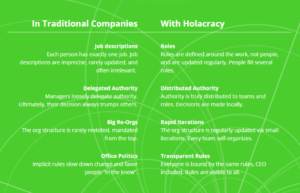As early as 2012, Josh Bersin’s keynote at Deloit’s Impact Conference, focused specifically on how Agile, “the ability to create and respond to change in order to succeed in an uncertain and turbulent environment” was essential for businesses to be nimble and responsive, as the landscape changes frequently and in unexpected ways.
Inflexible structures and rigid hierarchies may work when the world moves slowly and predictably, but they block innovation, waste time, and prevent organizations from taking advantage of new opportunities. These designs and methods are already being phased out, in progressive companies.
McKinsey’s report from October 2017 indicates that organizational agility is catching fire. While only 4% of their respondents say their companies have fully implemented organizational wide transformations, 37% say they are in progress. The survey also confirms agility pays off. 81% of respondents in agile units report a significant increase in overall performance since their transformations began. Agile business units excel at strategy and people-related practices, and they outperform all other units in stability and dynamism. More than 90% of agile respondents say that their leaders provide actionable strategic guidance (that is, each team’s daily work is guided by concrete outcomes that advance the strategy); that they have established a shared vision and purpose (namely, that people feel personally and emotionally engaged in their work and are actively involved in refining the strategic direction); and that people in their unit are entrepreneurial (in other words, they proactively identify and pursue opportunities to develop in their daily work). So who are these progressive companies?
Agile Success Stories
ING
In the summer of 2015, the Dutch banking group ING shifted its traditional organization to an “agile” model inspired by companies such as Google, Netflix, and Spotify. Comprising about 350 nine-person “squads” in 13 so-called tribes, the new approach at ING improved time to market, boosted employee engagement, and increased productivity. For ING, ‘Agile’ meant they had to stop thinking traditionally about product marketing and start understanding customer journeys in this new omnichannel environment. To provide a seamless and consistently high-quality service so that customers can start their journey through one channel and continue it through another—for example, going to a branch in person for investment advice and then calling or going online to make an actual investment.
Bart Schlatmann, COO, speaks of the company’s goals, in an interview with McKinsey in Jan 2017:
“Agility is about flexibility and the ability of an organization to rapidly adapt and steer itself in a new direction. It’s about minimizing handovers and bureaucracy, and empowering people. The aim is to build stronger, more rounded professionals out of all our people …. the key has been adhering to the “end-to-end principle” and working in multidisciplinary teams, or squads, that comprise a mix of specialists—all focused on solving the client’s needs and united by a common definition of success”.
INGs’ four key steps to creating an Agile organization:
- Multi-disciplinary ‘squads’ sit together in the same building,
- A flat structure without managers controlling handovers and slowing down collaboration.
- A continuous delivery mindset, new software releases on a much more frequent basis – every two weeks rather than having five to six ‘big launches’ a year.
- A new compensation model where salaries are not based on status or size of but how people deal with knowledge and work together.
ING’s key takeaway is to make Agile a complete organizational change, do not cherry pick departments or functions. For example, some people formally embrace the agile way of working but do not let go of their existing organizational structure and governance. That defeats the whole purpose and only creates more frustration.
Always consider the broader purpose to make the transformation a success and remember culture is the most important element. You will need to invest energy and leadership time role modelling the desired behaviors — ownership, empowerment, customer centricity—that are necessary in an agile culture. ING requested everyone reapply for positions in the new organization and the selection process was intense, with a higher weighting for culture and mind-sets than knowledge or experience.
Zappos.com
Another example of organizational agility is zappos.com. CEO, Tony Hsieh says “research shows that every time the size of a city doubles, innovation or productivity per resident increases by 15%. But when companies get bigger, innovation or productivity per employee generally goes down. So we’re trying to figure out how to structure Zappos more like a city, and less like a bureaucratic corporation. In a city, people and businesses are self-organizing. We’re trying to do the same thing by switching from a normal hierarchical structure to a system called Holacracy, which enables employees to act more like entrepreneurs and self-direct their work instead of reporting to a manager who tells them what to do.”

Zappos key elements are based on three guiding principles – 1. the structure allows the freedom, 2. power generally gets in the way of learning and 3. learning happens when people feel comfortable sharing, speaking up, and raising issues.
These organizations show the benefits of adaptability, efficiency, collaboration and execution and have already crossed over from IT and Engineering to organizational management. If you’re not ready to go the whole nine yards yet, in our next blog we explain how you can make it work on a smaller scale, say for example your HR department.
Stay tuned

